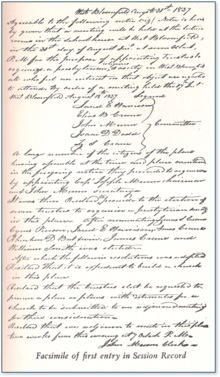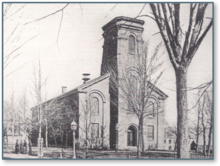
Bloomfield is a township in Essex County, in the U.S. state of New Jersey. As of the 2020 United States census, the township's population was 53,105, an increase of 5,790 (+12.2%) from the 2010 census count of 47,315, which in turn reflected a decline of 368 (-0.8%) from the 47,683 counted in the 2000 census. It surrounds the Bloomfield Green Historic District.

Montclair is a township in Essex County in the U.S. state of New Jersey. Situated on the cliffs of the Watchung Mountains, Montclair is a commercial and cultural hub of North Jersey and a diverse bedroom community of New York City within the New York metropolitan area. The township is the home of Montclair State University, the state's second-largest university.
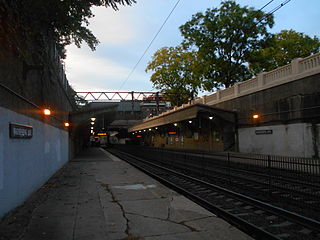
Watsessing Avenue station is a New Jersey Transit rail station in Bloomfield, New Jersey, along the Montclair-Boonton Line. It is located beneath the Bloomfield Police Benevolent Association meeting hall near the corner of Watsessing Avenue and Orange Street in Bloomfield. It is one of two stations on the line where the boarding platform is below ground level. The Watsessing station and the Kingsland station in Lyndhurst on the Main Line shared similar designs and were built about the same time.

Bloomfield is a New Jersey Transit station in Bloomfield, New Jersey, located along the Montclair-Boonton Line. The station is located in downtown Bloomfield, the second within the municipality, just west of Bloomfield Avenue. This is the second station within the township served on the line after Watsessing Avenue station.

Upper Montclair is a New Jersey Transit station in Upper Montclair, New Jersey, a census-designated place of Montclair, New Jersey. The station is part of the Montclair-Boonton Line. The station is located between two grade level crossings on Bellevue Avenue and Lorraine Avenue, and between North Mountain Avenue and Upper Montclair Plaza parallel to the railroad, and is within steps of the Upper Montclair Business District. The station is 13.7 miles (22.0 km) on the Boonton Line. Closing the grade crossing of Lorraine Avenue is being considered for safety reasons.
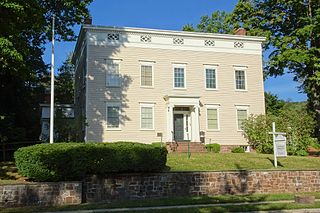
The Crane House and Historic YWCA is a federal-style home located at 110 Orange Road in Montclair, Essex County, New Jersey. The house has had a rich history and was added to the National Register of Historic Places on March 14, 1973, for its significance in architecture, conservation, and industry.

Ampere, formerly known as The Crescent, is a defunct stop on New Jersey Transit's Montclair-Boonton Line in the city of East Orange, Essex County, New Jersey, United States. A station was first built there in 1890 to service to new Crocker Wheeler plant in the district. The stop was named in honor of André-Marie Ampère, a pioneer in electrodynamics and reconstructed as a new Renaissance Revival station in 1908. Ampere was the second stop on the branch west of Newark Broad Street Station until 1984, when the Roseville Avenue station was closed. In June of that year, the station, along with 42 others, was entered into the National Register of Historic Places. In 1986, after continuous deterioration, New Jersey Transit demolished the westbound shelter built in 1921. The agency discontinued rail service to Ampere on April 7, 1991. The entire station was demolished in 1995.

The Grover Cleveland Birthplace is a historic site located at 207 Bloomfield Avenue in Caldwell, Essex County, New Jersey, United States. It is the only house museum dedicated to U.S. President Grover Cleveland.

The Montclair-Boonton Line is a commuter rail line of New Jersey Transit Rail Operations in the United States. It is part of the Hoboken Division. The line is a consolidation of three individual lines: the former Delaware, Lackawanna & Western Railroad's Montclair Branch, which ran from Hoboken Terminal to Bay Street, Montclair; the Erie Railroad's Greenwood Lake Division, which originally ran from the Erie's Jersey City Terminal to Greenwood Lake, NY; and the former Lackawanna Boonton Line, which ran from Hoboken to Hackettstown, New Jersey. The Montclair-Boonton line was formed when the Montclair Connection opened on September 30, 2002. The line serves 28 active rail stations in New Jersey along with New York Pennsylvania Station. It crosses through six counties, serving six stations in the township of Montclair, two in the town of Bloomfield, and one in the city of Newark. Trains along the Montclair-Boonton Line heading eastward usually originate at Hackettstown, Mount Olive, Lake Hopatcong, Dover, or Montclair State University, bound for either Hoboken Terminal or New York Penn Station. On system maps the line is colored maroon and its symbol is a bird, after the state bird, the eastern goldfinch.

The Congregational Church, also known as the First Congregational Church of Montclair, is a historic United Church of Christ church located at 42 South Fullerton Avenue in the township of Montclair in Essex County, New Jersey, United States. The church was designed by the architect Bertram Grosvenor Goodhue and features Perpendicular Gothic style. It was added to the National Register of Historic Places on July 1, 1988, for its significance in architecture. Eleanor Price notes in the nomination form that it is "one of the finest examples of Gothic church architecture in the country". It was listed in the Churches section of the Historic Resources of Montclair Multiple Property Submission (MPS).
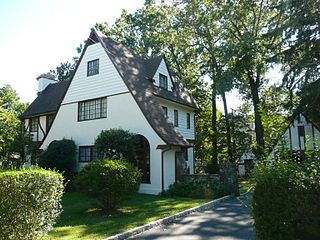
The House that Lives is a historic house located at 83 Watchung Avenue in the township of Montclair in Essex County, New Jersey, United States. It was built in 1922 and designed by architect Clifford C. Wendehack with Modern Movement and Tudor Revival elements. The house was added to the National Register of Historic Places on July 1, 1988, for its significance in architecture. It was listed in the Selection of Montclair's Published Houses section of the Historic Resources of Montclair Multiple Property Submission (MPS).

Trinity Episcopal Church is a historic church located at 650 Rahway Avenue in Woodbridge Township of Middlesex County, New Jersey. The third church at this location, it was added to the National Register of Historic Places on May 12, 2004, for its significance in architecture and religion.

Pataskala Presbyterian Church is a historic church at Atkinson and Main Streets in Pataskala, Ohio. It was built in 1868 and added to the National Register in 1983.

George DeWitt Mason was an American architect who practiced in Detroit, Michigan, in the latter part of the 19th and early decades of the 20th centuries.

The Lamington Historic District is a 84-acre (34 ha) historic district located along Lamington, Black River, Rattlesnake Bridge, and Cowperthwaite Roads in the Lamington section of Bedminster Township in Somerset County, New Jersey. It was added to the National Register of Historic Places on June 21, 1984, for its significance in architecture, exploration/settlement, and religion. The district includes 11 contributing buildings and 3 contributing sites.
Francis Augustus Nelson (1878–1950) was an American architect from Montclair, New Jersey.

The Old Stone Church is a historic sandstone church located in Kingwood Township in Hunterdon County, New Jersey, United States. It was built in 1837 and is now owned by the First Unitarian Universalist Fellowship of Hunterdon County. The church, described using its historic name, Old Stone Presbyterian Church in Kingwood, was added to the National Register of Historic Places on January 25, 2018 for its significance in architecture. The earlier church located here was a smaller stone building built in 1755, called the Old Stone Meetinghouse. The stones from this church were probably used to build the current one. The Kingwood congregation was established in 1728 and grew during the First Great Awakening, with Gilbert Tennent and George Whitefield preaching here in 1739.

The Morristown District, also known as the Morristown Historic District, is a historic district in the town of Morristown in Morris County, New Jersey. It was added to the National Register of Historic Places on October 30, 1973, for its significance in architecture, communications, education, military, politics, religion, social history, and transportation.

The Pine Street Historic District is a 26.6-acre (10.8 ha) historic district encompassing a residential section of the township of Montclair and extending into the borough of Glen Ridge, both in Essex County, New Jersey. It is roughly bounded by Glenridge Avenue, the NJ TRANSIT Boonton Line, Pine and Baldwin Streets. The district, also known as the Montclair Working Class Housing Historic District, was added to the National Register of Historic Places on March 16, 2000 for its significance in architecture and social history. The district includes 107 contributing buildings.

The Blackwell Street Historic District is a 25-acre (10 ha) historic district along Blackwell, Dickerson, Sussex, Bergen, Essex, Morris, Warren, Prospect and Dewey streets in the town of Dover in Morris County, New Jersey. It was added to the National Register of Historic Places on May 21, 1982, for its significance in architecture, commerce, education, performing arts, religion, and transportation.




